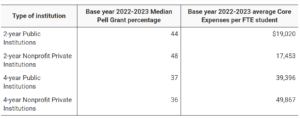Navigating the world of grants has always been a bit of a rollercoaster. There are a number of benefits—securing funding that powers your mission, expanding your reach, and making a real impact. Grants can also be daunting. Right now one of the biggest challenges facing colleges and universities is the uncertainty around the future of federal funding.
As the landscape continues to evolve, it’s clear that success in the world of grants isn’t just about adapting to funding cuts—it’s about embracing a future where intelligence drives your grant strategy. Whether you’re diversifying your funding with state and foundation opportunities or simply getting smarter about how you approach grant proposals, staying informed is the key to thriving in the current environment.
Thinking Outside the Box: Your New Grants Strategy
Every new administration brings with it new priorities, new funding opportunities and changes to existing programs and funding opportunities. This administration is no different.
In a recent episode of EAB’s podcast, Senior Vice President and Leader of the Higher Education Practice at McAllister & Quinn, Dr. Jessica Gerrity, and EAB’s Tara Zirkel, Director of Strategic Research, discuss how these cuts are affecting grant strategies and offer actionable advice for navigating this challenging environment. They also share tips on how university leaders might adapt grant strategies in the months ahead.
Click here to listen to the full episode.
Stay Ahead of the Curve
The landscape of federal funding for higher education is evolving…quickly. Knowing what is going on in DC is fundamental to staying competitive with federal grants. Here are four ways to make sure you stay in the game:
Stay Informed: The federal budget process is long and often confusing. Don’t panic when programs are paused or delayed. Stay informed by following updates from trusted sources.
Diversify Your Funding Sources: Consider state and local grants, corporate sponsorships, and private foundations. Don’t rely on just one funding stream—casting a wider net increases your chances of success!
Refine Your Grant Proposals: Tailor each proposal to align with the latest funding priorities. Make sure your proposals clearly show the impact your organization will make and how your project fits within the funder’s priorities.
Embrace the Shift: The political climate creates new opportunities. Workforce development, for example, is expected to be a priority area in future funding cycles, so institutions should start planning strategies around this theme.
Looking Ahead: Grants Intelligence Service
With the right tools and strategies in place, you’ll be ready to navigate the grants landscape and quickly pivot to apply for available funding. Grants Intelligence Service (GIS) delivers expert-driven, real-time federal funding insights to position your institution for success—powered by the proven expertise of McAllister & Quinn.
At a time when many institutions may not be submitting grants due to perceived uncertainty, McAllister & Quinn is working closely with clients to ensure they are in the queue and ready to be reviewed… and funded!
Click here or fill out the form below for a FREE grants consultation!

